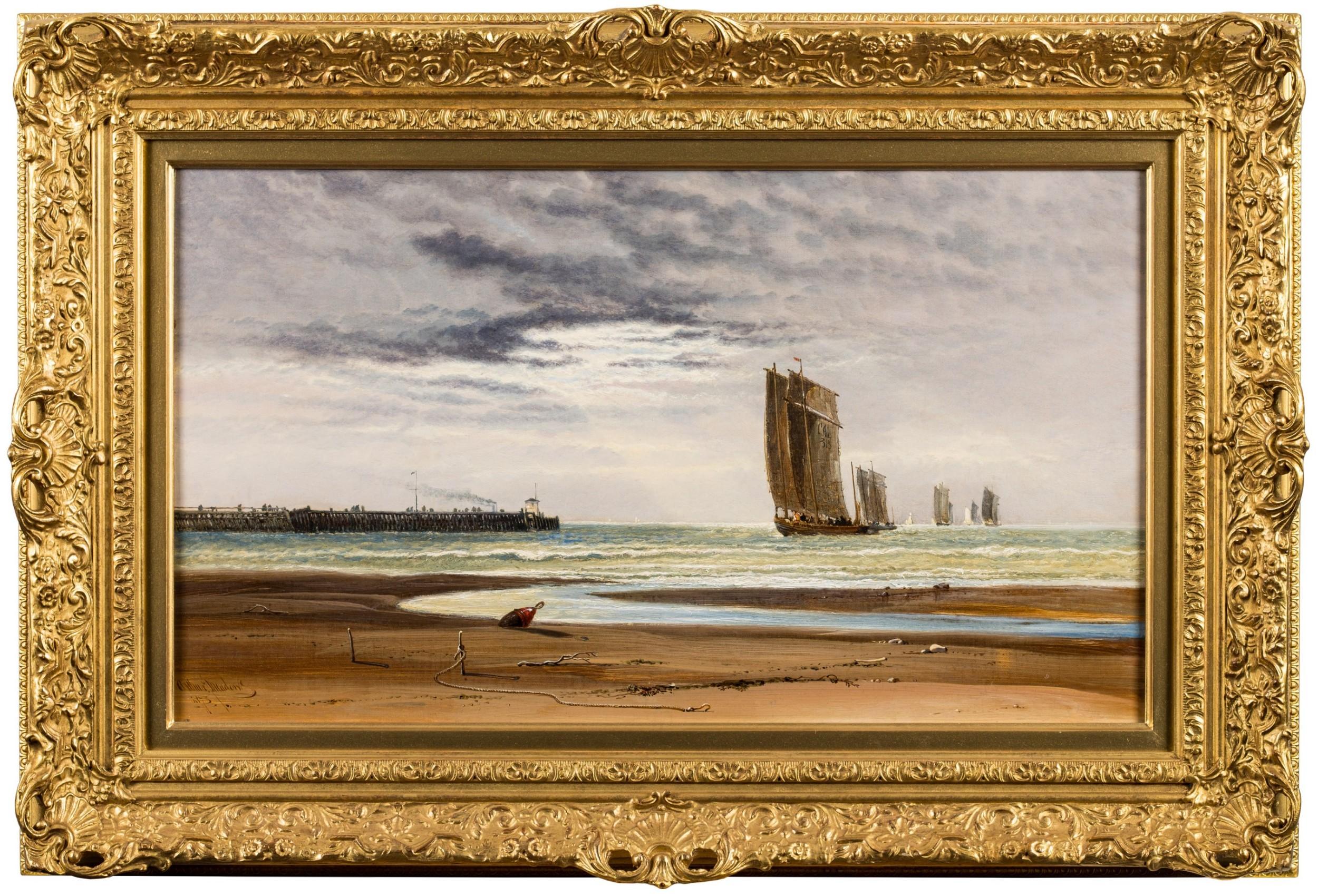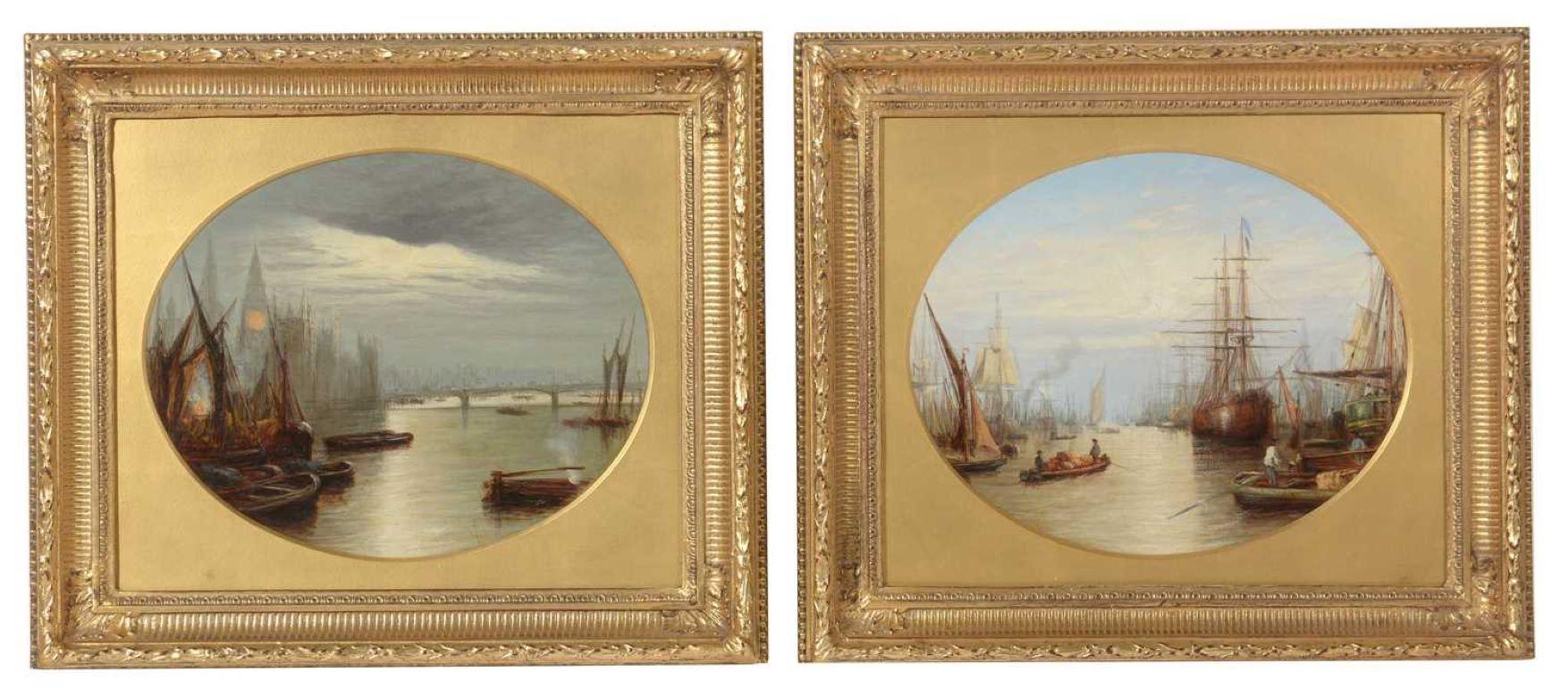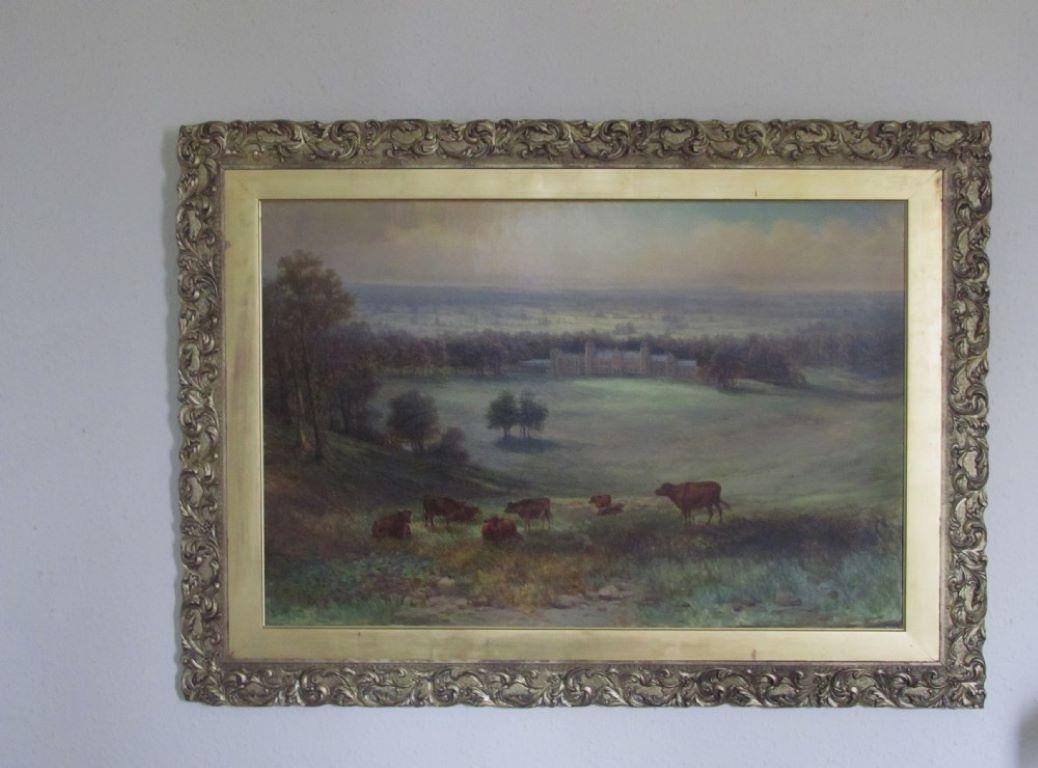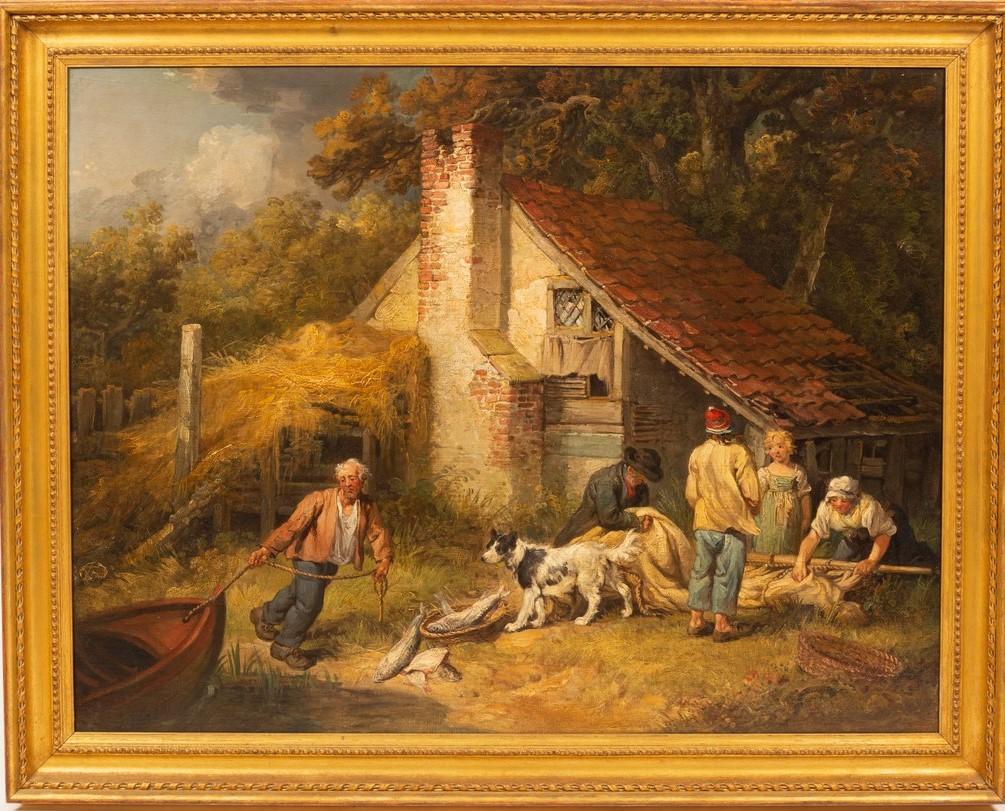Items Similar to Horses and stagecoach winter/snow scene, oil painting, by John Richard Worsdale
Want more images or videos?
Request additional images or videos from the seller
1 of 12
John Richard WorsdaleHorses and stagecoach winter/snow scene, oil painting, by John Richard Worsdale19th century
19th century
About the Item
A fine antique oil painting of horses pulling a stagecoach in snow , by John richard Worsdale (1869-1947)
The artist portrays this powerful scene with an extensive view, featuring the stagecoach pulled by 4 horses
and a village scene behind with buildings and peopla with another coach behind.
oil on canvas, signed lower left, housed in a gilt frame.
The size of the painting is approx 74 cms x 49 cms, whilst framed size is 90cm x 67cm.
The painting is in very good condition, relined, with only some minor craquelure to the skyline,
The frame appears original and is also in good condition with only minor age wear.
Provenance: The E. W. Towler Collection, formerly of Glympton Park, Woodstock, Oxfordshire.
Eric W. Towler was a remarkable man. He was born in 1900 and left school at the age of 12 to work in a Yorkshire pit and through a lifetime of hard work, self-improvement, luck and a refusal to limit his horizons achieved many of his aspirations.
As a Yorkshireman through and through, he believed in ‘spending the brass in his pocket’ and over time he was successful enough to acquire enough ‘brass’ to enable his purchase of Glympton Park and furnish it as a traditional country house with all the trappings – in his case collections of antique furniture, rugs, sporting oils and clocks.
His first step was to move from the pit to an apprentice as a bank clerk, where he claimed to have learned to ‘mek the tea’ but seems also to have acquired skills in book-keeping, which after a period as an Able Seaman in the RNVR during the end of the first world war, served him well in his future entrepreneurial journey. At the age of twenty-one, he vouchsafed all he had into a small coal dealing business, where his gift for sales led to an early invitation to be their Sales Director, and the rest is history.
Early in his life, Eric was able to achieve one of his aspirations. He described looking in awe through the gates of Tong Hall – a large Yorkshire property in a rural location near his home and during his thirties, funded by his growing success in a variety of industrial entrepreneurial roles, he was able to acquire it, and instead look out through the gates. This was first of a series of substantial properties, and his interest in farming.
His down to earth nature, knowledge and interest in newly emergent farming technologies led to a productive collaboration with Tom Williams, who was set the task of digging for Britain as Minister of Agriculture, and he continued his interest in farming through a number of estates in Yorkshire, Shropshire and Somerset before eventually settling at Glympton Park in Oxfordshire. Here he stewarded the development and modernisation of a large mixed estate covering everything from cereals, the latest forage crops to his pedigree Red Devon beef cattle, Suffolk sheep, dairy cows and pigs.
Eric was keen to enjoy every aspect of the land, and loved country sports and shooting, but particularly enjoyed fox hunting – a passion he continued for life. He managed to become Joint Master of the Badsworth Hunt in his early thirties, with the force and accessibility of his personality overcoming what some saw as a limitation of his humble background. When not on the hunting field his interest in horses extended from the practicalities of carriage driving to sporting oils, notably by Ferneley and Herring some of which are in this auction.
In Oxfordshire, in true renaissance style, he diversified from business to health service management as Chairman of the Nuffield, the Radcliffe, United Oxford Hospitals thus ‘ticking off’ another aspiration of his to be a doctor (as he initially saw it). This is a reflection of his compassionate nature to relieve suffering, which we can perhaps understand when he describes the only access to dentistry in the Yorkshire village of his childhood around 1910, being the village policeman who would attempt its removal with a pair of pliers. Much of the credit for planning of the John Radcliffe goes to Eric, and for all of this he was awarded the C.B.E and an honorary M.A by Oxford University. Various hospital features now proudly bear his name.
Eric W. Towler was known for his deep kindness, generosity, and desire to help others, especially the young. He was truly a man who understood, lived, loved, and embodied country pursuits as well as ‘spending the brass’.
his paintings have been in his hands for 50 years
- Creator:John Richard Worsdale (British)
- Creation Year:19th century
- Dimensions:Height: 26.38 in (67 cm)Width: 35.44 in (90 cm)
- Medium:
- Movement & Style:
- Period:
- Condition:
- Gallery Location:York, GB
- Reference Number:1stDibs: LU1800213535122
About the Seller
5.0
Vetted Seller
These experienced sellers undergo a comprehensive evaluation by our team of in-house experts.
Established in 1991
1stDibs seller since 2022
13 sales on 1stDibs
Typical response time: 8 hours
- ShippingRetrieving quote...Ships From: York, United Kingdom
- Return PolicyA return for this item may be initiated within 2 days of delivery.
More From This SellerView All
- Arthur Joseph Meadows 19th Century Seascape Off CalaisBy Arthur Joseph MeadowsLocated in York, GBA very fine painting by the renowned seascape painter Arthur Joseph Meadows,Off Calais; fishing fleet returning at low tide. Housed in an antique style gilt frame the size overall is...Category
19th Century Old Masters Landscape Paintings
MaterialsOil
- 19th century oil, view London, the Thames, houses parliament, Francis MaltinoLocated in York, GBA fine pair of oil paintings, oil on board depicting views of the Thames one showing houses of parliament the other barges in busy shipping lane. Framed and Glazed the size being 26 ...Category
19th Century Old Masters Landscape Paintings
MaterialsOil
- 19th Century, Victorian, landscape , cows , Country House Samuel Lawson BoothLocated in York, GBS Lawson Booth : Country House in extensive landscape with cattle in the foreground, oil on canvas signed and dated '98, 60cm x 90cm (35x23 inches approx image) size with frame appro...Category
19th Century Old Masters Landscape Paintings
MaterialsOil
- James ward landscape oil Bringing in the CatchBy James WardLocated in York, GBJames ward landscape oil Bringing in the Catch A charming scene of a family "bringing in the catch" showing figures outside a cottage, man pullng in the boat with his dog watching by...Category
19th Century Old Masters Landscape Paintings
MaterialsOil
- St Michael's Mount, Cornwall Seascape OilLocated in York, GBThis early 20th century oil on canvas depicts a nautical scene with a view of St Michaels Mount beyond. Although as yet, not attributed to a particular artist,this painting has cl...Category
Early 20th Century Old Masters Landscape Paintings
MaterialsOil
- Hastings Castle oil painting seascape 19th century, William Edward WebbBy William Edward WebbLocated in York, GBHastings Castle from the beach oil William Edward Webb A fine 19th century oil on canvas painting depicting Hastings Castle from the beach with fishermen and boats housed in a git ...Category
19th Century Old Masters Landscape Paintings
MaterialsOil
You May Also Like
- Early oil depicting the Great Fire of LondonLocated in London, GBThe Great Fire of London in September 1666 was one of the greatest disasters in the city’s history. The City, with its wooden houses crowded together in narrow streets, was a natural fire risk, and predictions that London would burn down became a shocking reality. The fire began in a bakery in Pudding Lane, an area near the Thames teeming with warehouses and shops full of flammable materials, such as timber, oil, coal, pitch and turpentine. Inevitably the fire spread rapidly from this area into the City. Our painting depicts the impact of the fire on those who were caught in it and creates a very dramatic impression of what the fire was like. Closer inspection reveals a scene of chaos and panic with people running out of the gates. It shows Cripplegate in the north of the City, with St Giles without Cripplegate to its left, in flames (on the site of the present day Barbican). The painting probably represents the fire on the night of Tuesday 4 September, when four-fifths of the City was burning at once, including St Paul's Cathedral. Old St Paul’s can be seen to the right of the canvas, the medieval church with its thick stone walls, was considered a place of safety, but the building was covered in wooden scaffolding as it was in the midst of being restored by the then little known architect, Christopher Wren and caught fire. Our painting seems to depict a specific moment on the Tuesday night when the lead on St Paul’s caught fire and, as the diarist John Evelyn described: ‘the stones of Paul’s flew like grenades, the melting lead running down the streets in a stream and the very pavements glowing with the firey redness, so as no horse, nor man, was able to tread on them.’ Although the loss of life was minimal, some accounts record only sixteen perished, the magnitude of the property loss was shocking – some four hundred and thirty acres, about eighty per cent of the City proper was destroyed, including over thirteen thousand houses, eighty-nine churches, and fifty-two Guild Halls. Thousands were homeless and financially ruined. The Great Fire, and the subsequent fire of 1676, which destroyed over six hundred houses south of the Thames, changed the appearance of London forever. The one constructive outcome of the Great Fire was that the plague, which had devastated the population of London since 1665, diminished greatly, due to the mass death of the plague-carrying rats in the blaze. The fire was widely reported in eyewitness accounts, newspapers, letters and diaries. Samuel Pepys recorded climbing the steeple of Barking Church from which he viewed the destroyed City: ‘the saddest sight of desolation that I ever saw.’ There was an official enquiry into the causes of the fire, petitions to the King and Lord Mayor to rebuild, new legislation and building Acts. Naturally, the fire became a dramatic and extremely popular subject for painters and engravers. A group of works relatively closely related to the present picture have been traditionally ascribed to Jan Griffier...Category
17th Century Old Masters Landscape Paintings
MaterialsOil, Canvas
- Stag Hunting in the Vicinity of Nuremberg by a German Artist Peter von BemmelLocated in PARIS, FRThis small landscape shows a hunting scene: two riders are chasing a stag with their dogs at the edge of a forest. Signed by Peter von Bemmel, it is typical of the production of this...Category
1720s Old Masters Landscape Paintings
MaterialsCopper
- 18th Century By Vincenzo Re The Pool of Bethesda Oil on CanvasLocated in Milano, LombardiaExpertise by Prof. Giancarlo Sestieri. Vincenzo Re (Parma, 1695 – Napoli?, 1762) born in Parma, was an Italian scenic designer who during his career worked as initially an assistant...Category
18th Century Old Masters Landscape Paintings
MaterialsCanvas, Oil
- 17th Century by Simone Cantarini Adoration of The Magi Painting Oil on CanvasLocated in Milano, LombardiaSimone Cantarini (Pesaro 1612 - Verona 1648) Adoration of the Magi Oil on paper applied to canvas, cm. 16,5 x 24 – with frame cm. 22 x 29 Antique sh...Category
Early 17th Century Old Masters Figurative Paintings
MaterialsCanvas, Cotton Canvas, Oil
- 18th Century by Antonio Stom Architectural Capriccio Oil on Canvas_By Antonio StomLocated in Milano, LombardiaAntonio Stom (Venice c. 1688 - 1734) Architectural Capriccio oil on canvas, cm. 88 x 113 - with frame cm. 106 x 132 Carved, sculpted and gilded wooden frame Expertise: Giancarlo S...Category
Early 18th Century Old Masters Landscape Paintings
MaterialsCanvas, Cotton Canvas, Oil
- 18th Century by Giuseppe Pianca Shepherd with Goat and River Oil on CanvasLocated in Milano, LombardiaGiuseppe Antonio Pianca (Agnona di Borgosesia/VC, 1703 - after 1757) oil on canvas, cm. 49 x 57 - with frame cm. 67 x 77 Antique shaped wooden cassetta frame, ebony and gold decora...Category
18th Century Old Masters Landscape Paintings
MaterialsCanvas, Cotton Canvas, Oil
Recently Viewed
View AllMore Ways To Browse
Red Pig
Korean Movie Poster
Sunset Cliffs
Vintage Night Oil Painting
John Paul Morgan
Large Wal Art
Art From Sofia Bulgaria
Best Original Oil Painting To Buy
Sailor Cup
Snow Impressionist Painting
Jan Rogers Autumn
William Campbell Gallery
20x20 Frame
St Barts Artwork
Frank Holmes
1930s Painted Swedish Box
Kit Carson
Little Tree





